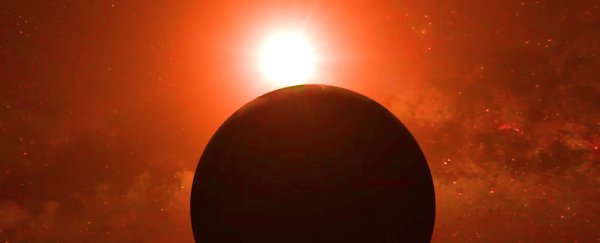We are surrounded by alien worlds. In neighbouring star systems, Earth-like planets abound, with unusual names like Proxima b, TRAPPIST–1e, Ross–128b, and LHS–1140b.
Are these strange places habitable? Are they homes for life-forms we can't yet imagine? The jury is out. While these exoplanets all orbit within the so-called habitable aka Goldilocks zones of their host stars, there's something else about them we can't ignore: hellfire.
Not actual, metaphysical hellfire, of course, but the closest cosmic equivalent – intense solar radiation.
Planets orbiting M-type (red dwarf) stars are subject to brutal solar flare activity that scientists fear might extinguish their hypothetical biospheres, if not sterilise them entirely.
But a new study by astronomers at Cornell University suggests there's yet hope for alien life in these fierce environments – even in the face of blistering ultraviolet (UV) radiation.
To find that hope, we need to consider the back-story of a habitable zone (HZ) planet we already know a fair bit about. Earth.
"The history of life on Earth provides us with a wealth of information about how biology can overcome the challenges of environments we would think of as hostile," says astronomer Jack O'Malley-James.
Together with fellow researcher Lisa Kaltenegger, O'Malley-James modelled the amount of UV flux these four closest potentially habitable exoplanets (Proxima b, TRAPPIST–1e, Ross–128b, and LHS–1140b) might be exposed to on the surface, and compared it with what we experience on Earth.
In the simulations, they looked at a range of different atmospheric compositions, as thicker atmospheres can shield the surface from the harmful effects of UV radiation more effectively than thinner (eroded or anoxic) atmospheres.
Ultimately, Earth's atmosphere – and our proximity to our own yellow dwarf Sun – win out in the habitability vs hellfire stakes. But it wasn't always the case.
"Even though these planets in the HZs of active star systems receive higher UV fluxes than present-day Earth, their UV surface flux is lower than that of the early Earth 3.9 billion years ago," the authors explain in their paper.
"Thus even if planets around active M stars have eroded atmospheres or do not contain ozone (anoxic), the resulting surface UV flux is still approximately an order [of] magnitude lower than on the early Earth even for the planet orbiting the most active star in our sample, Proxima b."

In other words, Earth is a better place for you me today than the UV-irradiated environments of the four closest potentially habitable planets we know about so far.
But billions of years ago, even more intense levels of radiation didn't prohibit the survival and evolution of ancient, primordial life-forms on our own home planet.
By extension, the researchers think we shouldn't discount the possibility that – maybe, just maybe – aliens are similarly getting on with it and coping as best they can in places like Proxima b and elsewhere, relatively insane levels of UV flux notwithstanding.
"While the anoxic atmosphere does result in a considerably more biologically harmful radiation environment compared to the present-day Earth, it is still approximately an order of magnitude less biologically harmful than early Earth's," the team writes.
"Therefore, UV surface radiation levels should not rule out surface habitability for our closest potentially habitable planets or for planets orbiting in the HZ of active M stars in general."
That's all pretty positive stuff, as far as the search for alien life goes, but the researchers also invoke another tantalising possibility, pointing out some studies have actually suggested "high UV surface flux may even be necessary for prebiotic chemistry to occur".
To follow that line of thought, it's possible life doesn't evolve despite cosmic hellfire, but because of it.
There's a lot more science to be done before we get to the bottom of that, but suffice to say, it's way too early to give up on these unenviable (but perhaps not so inhospitable) exoplanets just yet.
The findings are reported in Monthly Notices of the Royal Astronomical Society.
